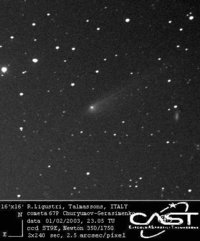67P/Churyumov-Gerasimenko
|
|
67P/Churyumov-Gerasimenko is the designation of a comet with a current orbital period of 6.6 years. It is the destination of the European Space Agency's Rosetta spacecraft mission, launched on March 2, 2004.
| Contents |
Comet parameters
| Diameter: | 4 km |
| Orbital period: | 6.6 years |
| Orbital eccentricity: | 0.6 |
| Orbital inclination: | 7.1 degrees |
| Discovered: | 1969 |
Hubble pictures
Comete_rosetta_byhubble.jpg
Discovery
This comet was discovered by Klim Ivanovic Churyumov who examined a photograph exposed for periodic comet 32P/Comas Solá by Svetlana Ivanovna Gerasimenko on September 11, 1969 at the Alma-Ata Astrophysical Institute. He found a cometary object near the edge of the plate, but assumed that this was Comas Solá. After returning to his home institute in Kiev, all photographic plates were investigated closely. About a month after the photograph was taken (October 22), it was discovered that the object could not be the assumed comet, because it was about 1.8 degrees off the expected position. Further scrutiny produced a faint picture of Comas Solá at its expected position on the plate, thus proving that the other object was a newly discovered comet.
Orbital history
Churyumov-Gerasimenko has a rather interesting orbital history. Comets are regularly nudged from one orbit to another when they encounter Jupiter or Saturn in close proximity. For this comet it was calculated, that before the year 1840 it was completely unobservable due to its perihelion distance of about 4.0 AU. At this time Jupiter shifted that distance to about 3.0 AU. Later on, in the year 1959, another encounter with Jupiter pushed it to about 1.28 AU, where it is now.
External links
- IAU Ephemerides page for 67P (http://cfa-www.harvard.edu/iau/Ephemerides/Comets/0067P.html)
- Detailed description of 67P with light curves and pictures (http://www.iac.es/galeria/mrk/comets/67p/67p.htm)de:Tschurjumow-Gerasimenko
fr:Comčte Churyumov-Gerasimenko nl:67P/Churyumov-Gerasimenko

